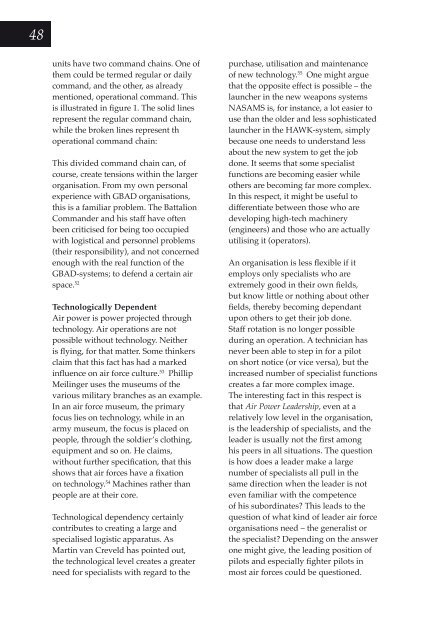REVIEW - Royal Air Force Centre for Air Power Studies
REVIEW - Royal Air Force Centre for Air Power Studies
REVIEW - Royal Air Force Centre for Air Power Studies
You also want an ePaper? Increase the reach of your titles
YUMPU automatically turns print PDFs into web optimized ePapers that Google loves.
48<br />
units have two command chains. One of<br />
them could be termed regular or daily<br />
command, and the other, as already<br />
mentioned, operational command. This<br />
is illustrated in figure 1. The solid lines<br />
represent the regular command chain,<br />
while the broken lines represent th<br />
operational command chain:<br />
This divided command chain can, of<br />
course, create tensions within the larger<br />
organisation. From my own personal<br />
experience with GBAD organisations,<br />
this is a familiar problem. The Battalion<br />
Commander and his staff have often<br />
been criticised <strong>for</strong> being too occupied<br />
with logistical and personnel problems<br />
(their responsibility), and not concerned<br />
enough with the real function of the<br />
GBAD-systems; to defend a certain air<br />
space. 52<br />
Technologically Dependent<br />
<strong>Air</strong> power is power projected through<br />
technology. <strong>Air</strong> operations are not<br />
possible without technology. Neither<br />
is flying, <strong>for</strong> that matter. Some thinkers<br />
claim that this fact has had a marked<br />
influence on air <strong>for</strong>ce culture. 53 Phillip<br />
Meilinger uses the museums of the<br />
various military branches as an example.<br />
In an air <strong>for</strong>ce museum, the primary<br />
focus lies on technology, while in an<br />
army museum, the focus is placed on<br />
people, through the soldier’s clothing,<br />
equipment and so on. He claims,<br />
without further specification, that this<br />
shows that air <strong>for</strong>ces have a fixation<br />
on technology. 54 Machines rather than<br />
people are at their core.<br />
Technological dependency certainly<br />
contributes to creating a large and<br />
specialised logistic apparatus. As<br />
Martin van Creveld has pointed out,<br />
the technological level creates a greater<br />
need <strong>for</strong> specialists with regard to the<br />
purchase, utilisation and maintenance<br />
of new technology. 55 One might argue<br />
that the opposite effect is possible – the<br />
launcher in the new weapons systems<br />
NASAMS is, <strong>for</strong> instance, a lot easier to<br />
use than the older and less sophisticated<br />
launcher in the HAWK-system, simply<br />
because one needs to understand less<br />
about the new system to get the job<br />
done. It seems that some specialist<br />
functions are becoming easier while<br />
others are becoming far more complex.<br />
In this respect, it might be useful to<br />
differentiate between those who are<br />
developing high-tech machinery<br />
(engineers) and those who are actually<br />
utilising it (operators).<br />
An organisation is less flexible if it<br />
employs only specialists who are<br />
extremely good in their own fields,<br />
but know little or nothing about other<br />
fields, thereby becoming dependant<br />
upon others to get their job done.<br />
Staff rotation is no longer possible<br />
during an operation. A technician has<br />
never been able to step in <strong>for</strong> a pilot<br />
on short notice (or vice versa), but the<br />
increased number of specialist functions<br />
creates a far more complex image.<br />
The interesting fact in this respect is<br />
that <strong>Air</strong> <strong>Power</strong> Leadership, even at a<br />
relatively low level in the organisation,<br />
is the leadership of specialists, and the<br />
leader is usually not the first among<br />
his peers in all situations. The question<br />
is how does a leader make a large<br />
number of specialists all pull in the<br />
same direction when the leader is not<br />
even familiar with the competence<br />
of his subordinates? This leads to the<br />
question of what kind of leader air <strong>for</strong>ce<br />
organisations need – the generalist or<br />
the specialist? Depending on the answer<br />
one might give, the leading position of<br />
pilots and especially fighter pilots in<br />
most air <strong>for</strong>ces could be questioned.

















